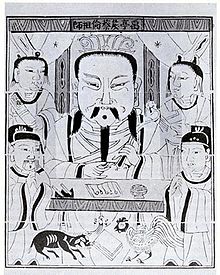 Cai Lun (AD 50-121) Inventor of paper
Cai Lun (AD 50-121) Inventor of paper
Cai Lun (Ts’ai Lun) was born in Guiyang during the Eastern Han Dynasty. After serving as a court eunuch from AD 75, he was given several promotions under the rule of Emperor He of Han. In AD 89 he was promoted with the title of Shang Fang Si, an office in charge of manufacturing instruments and weapons; he also became a Regular Palace Attendant. He was involved in palace intrigue as a supporter of Empress Dou, and in the death of her romantic rival, Consort Song. After the death of Empress Dou in AD 97, he became an associate of Consort Deng Sui.
In A.D. 105, Cai invented the composition for paper along with the papermaking process – though he may have been credited with an invention of someone from a lower class. Tools and machinery of papermaking in modern times may be more complex, but they still employ the ancient technique of felted sheets of fiber suspended in water, draining of the water, and then drying into a thin matted sheet. For this invention Cai would be world-renowned posthumously, and even in his own time he was given recognition for his invention. A part of his official biography written later in China reads thus:
In ancient times writings and inscriptions were generally made on tablets of bamboo or on pieces of silk called chih. But silk being costly and bamboo heavy, they were not convenient to use. Tshai Lun [Cai Lun] then initiated the idea of making paper from the bark of trees, remnants of hemp, rags of cloth, and fishing nets. He submitted the process to the emperor in the first year of Yuan-Hsing [+105] and received praise for his ability. From this time, paper has been in use everywhere and is universally called ‘the paper of Marquis Tshai
As listed above, the papermaking process included the use of materials like bark, hemp, silk, and fishing net; his exact formula has been lost. Emperor He was pleased with the invention and granted Cai an aristocratic title and great wealth.
After Empress Deng’s death, Consort Song assumed power. On coming to power he ordered Cai to report to prison. Fearing the worst, Cai took poison and committed suicide.
Influence
Although Cai Lun is little known outside of China, his paper invention has been one of the most critical inventions in the modern world. By the third century, paper making was commonly used, and this helped the development of Chinese civilisation through improved education, literacy and greater spread of knowledge.
Paper was slow to spread to the rest of the world. Paper was first introduced in Europe several centuries later, in the 12 century. However, once introduced, paper helped the spread of the Scholastic age in Christian Europe.



No comments:
Post a Comment